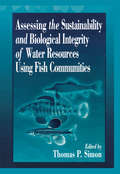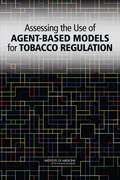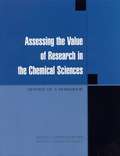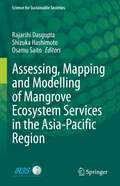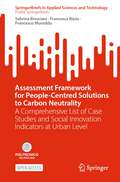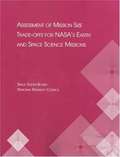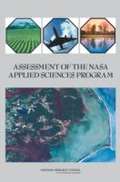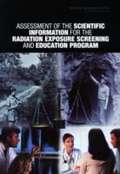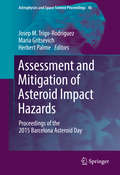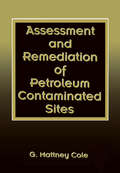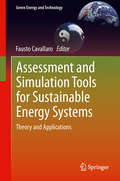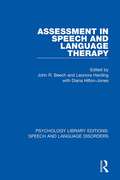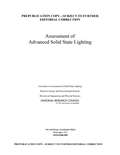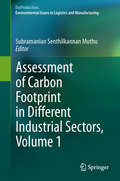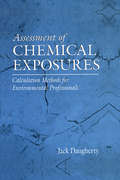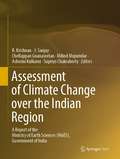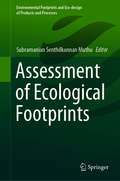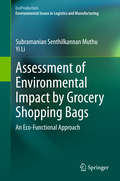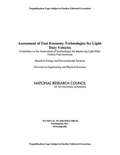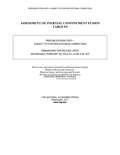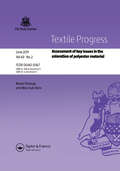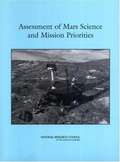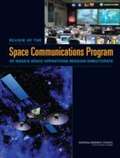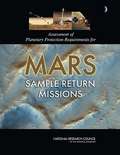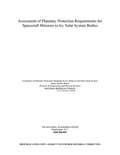- Table View
- List View
Assessing the Sustainability and Biological Integrity of Water Resources Using Fish Communities
by Thomas P. SimonThis book examines the application of fish community characteristics to evaluate the sustainability and biological integrity of freshwaters. Topics include perspectives on use of fish communities as environmental indicators in program development, collaboration, and partnership forming; influence of specific taxa on assessment of the IBI; regional applications for areas where the IBI had not previously been developed; and specific applications of the IBI developed for coldwater streams, inland lakes, Great Lakes, reservoirs, and tailwaters.
Assessing the Use of Agent-Based Models for Tobacco Regulation
by Robert WallaceTobacco consumption continues to be the leading cause of preventable disease and death in the United States. The Food and Drug Administration (FDA) regulates the manufacture, distribution, and marketing of tobacco products - specifically cigarettes, cigarette tobacco, roll-your-own tobacco, and smokeless tobacco - to protect public health and reduce tobacco use in the United States. Given the strong social component inherent to tobacco use onset, cessation, and relapse, and given the heterogeneity of those social interactions, agent-based models have the potential to be an essential tool in assessing the effects of policies to control tobacco. Assessing the Use of Agent-Based Models for Tobacco Regulation describes the complex tobacco environment; discusses the usefulness of agent-based models to inform tobacco policy and regulation; presents an evaluation framework for policy-relevant agent-based models; examines the role and type of data needed to develop agent-based models for tobacco regulation; provides an assessment of the agent-based model developed for FDA; and offers strategies for using agent-based models to inform decision making in the future.
Assessing the Value of Research in the Chemical Sciences: Report of a Workshop
by Chemical Sciences RoundtableThis book captures the messages from a workshop that brought together research managers from government, industry, and academia to review and discuss the mechanisms that have been proposed or used to assess the value of chemical research.The workshop focused on the assessment procedures that have been or will be established within the various organizations that carry out or fund research activities, with particular attention to the Government Performance and Results Act (GPRA). The book presents approaches and ideas from leaders in each area that were intended to identify new and useful ways of assessing the value and potential impact of research activities.
Assessing, Mapping and Modelling of Mangrove Ecosystem Services in the Asia-Pacific Region (Science for Sustainable Societies)
by Rajarshi Dasgupta Osamu Saito Shizuka HashimotoThis book presents the state-of-the-art of knowledge in assessing, mapping, and modeling mangrove ecosystem services and outlines various scientific tools and techniques, including environmental scenario-building, spatial and econometric modelling to understand the fluctuations and future availability of mangrove ecosystem services. The book also highlights the current gaps and measures in policy planning and outlines the avenues for capacity building. Through case studies and thematic reviews, the book plans to cater to a wide range of audiences, including students, researchers, and decision-makers at various levels involved in mangrove conservation and land use optimization for sustainable and resilient development. This book is particularly useful to researchers and students in the field of landscape and spatial ecology, coastal zone management, ecosystem services, and resilience planning. It is also a must-read for policymakers, conservators, coastal zone managers, foresters, and general administrators in understanding the current and future roles of mangroves in ecosystem-based adaptation through informed decision-making.
Assessment Framework for People-Centred Solutions to Carbon Neutrality: A Comprehensive List of Case Studies and Social Innovation Indicators at Urban Level (SpringerBriefs in Applied Sciences and Technology)
by Francesca Rizzo Sabrina Bresciani Francesco MuredduThis open access book presents a catalogue of over one thousand indicators which can be used by cities' public administrators to monitor and evaluate social innovation action plans to support people-centred, collaborative or co-designed solutions to lower carbon emissions. Indicators are clustered according to a framework of social innovation solutions for climate neutrality at city level, developed by merging top-down academic knowledge with bottom-up pragmatic case studies. There is currently limited guidance on how to embed social innovations in their cities’ action plans with the aim of reaching climate neutrality, and on how to assess the progress and impacts of such people-centred projects in cities. The book addresses this gap and is thus relevant for scholars in the field of policy-making and design, as well as cities’ transition teams, policymakers and consultants. Based on the work developed within the EU-funded project NetZeroCities, intervention logics are provided for each of the ten categories of action, with related indicators clustered by category and evaluation criteria (effectiveness, efficiency, relevance, replicability, and scalability). Guidelines to implement the framework support city administrators in defining steps they need to follow to apply the indicators to their local case, making social innovation a crucial lever for accelerating systemic transformation.
Assessment Of Mission Size Trade-offs For Nasa's Earth And Space Science Missions
by Ad Hoc Committee on the Assessment of Mission Size Trade-offs for Earth Space Science MissionsThe National Academies Press (NAP)--publisher for the National Academies--publishes more than 200 books a year offering the most authoritative views, definitive information, and groundbreaking recommendations on a wide range of topics in science, engineering, and health. Our books are unique in that they are authored by the nation's leading experts in every scientific field.
Assessment Of The Nasa Applied Sciences Program
by National Research Council of the National AcademiesRemote sensing data and models from the National Aeronautics and Space Administration (NASA) are the basis for a wide spectrum of scientific research endeavors and are key inputs to many public and private services. The NASA Applied Sciences Program (ASP) and its precursors have been tasked with ensuring the extension of NASA Earth observation data and associated research into practical applications for society through external partnerships. With approximately five years having elapsed under the current ASP structure, and a growing government-wide emphasis on societal benefits in its Earth observing programs, NASA and the ASP leadership asked the National Research Council to assess ASP's approach in extending NASA research results to practical, societal applications. The report recommends that ASP partnerships should focus not only federal agencies but alsoon direct engagement of the broader community of users. The report also recommends that ASP enhance communication and feedback mechanisms with its partners, with the end users and beneficiaries of NASA data and research, and with the NASA organization.
Assessment Of The Scientific Information For The Radiation Exposure Screening And Education Program
by National Academy of Sciences of the National AcademiesThe Radiation Exposure Compensation Act (RECA) was set up by Congress in 1990 to compensate people who have been diagnosed with specified cancers and chronic diseases that could have resulted from exposure to nuclear-weapons tests at various U. S. test sites. Eligible claimants include civilian onsite participants, downwinders who lived in areas currently designated by RECA, and uranium workers and ore transporters who meet specified residence or exposure criteria. The Health Resources and Services Administration (HRSA), which oversees the screening, education, and referral services program for RECA populations, asked the National Academies to review its program and assess whether new scientific information could be used to improve its program and determine if additional populations or geographic areas should be covered under RECA. The report recommends Congress should establish a new science-based process using a method called "probability of causation/assigned share" (PC/AS) to determine eligibility for compensation. Because fallout may have been higher for people outside RECA-designated areas, the new PC/AS process should apply to all residents of the continental US, Alaska, Hawaii, and overseas US territories who have been diagnosed with specific RECA-compensable diseases and who may have been exposed, even in utero, to radiation from U. S. nuclear-weapons testing fallout. However, because the risks of radiation-induced disease are generally low at the exposure levels of concern in RECA populations, in most cases it is unlikely that exposure to radioactive fallout was a substantial contributing cause of cancer.
Assessment and Mitigation of Asteroid Impact Hazards: Proceedings of the 2015 Barcelona Asteroid Day (Astrophysics and Space Science Proceedings #46)
by Josep M. Trigo-Rodríguez Maria Gritsevich Herbert PalmeCollecting the research presented at the Asteroid Day INTERNATIONAL WORKSHOP celebrated at Barcelona on June 30th, 2015,this proceedings discusses the new era that has just started in the study and exploration of solar system minor bodies. International Asteroid Day commemorates the Tunguska event of June 30th, 1908 in order to promote the importance of dealing proactively with impact hazards from space. Multidisciplinary experts contribute to this discussion in describing the nature of comets and asteroids along with their offspring, meteorites. New missions and space projects aimed at sampling Near Earth Asteroids to bring these materials back to Earth such as Osiris-REx and Hayabusa 2 are described,as well as the AIM and DART projects to test impact deflection techniques for Potentially Hazardous Asteroids encounters. The proceedings includes both an outreach level to popularize impact hazard, and a scientific character, compiling the most modern knowledge on these topics AND PROPOSING NEW TECHNIQUES TO GAIN INSIGHT ON THE PROPERTIES OF THESE CHALLENGING BODIES BY STUDYING METEOROIDS AND METEORITES. Asteroids, comets and meteorites are introduced with descriptions of their nature, origin, and solar system pathways.
Assessment and Remediation of Petroleum Contaminated Sites
by G. Mattney ColeFederal regulations have required thousands of underground storage tanks (USTs) to be dug up and removed or replaced. The contamination of soil and ground water from leaking USTs has become widespread and has produced an overwhelming number of sites that require remediation. Assessment and Remediation of Petroleum Contaminated Sites presents the broad scope of the remedial process from initial site assessment to closure in an integrated, understandable format. The book guides you effortlessly through regulatory requirements, site assessments and sampling, and remediation methods. RCRA and CERCLA federal regulations are addressed. The chemistry and toxicology of petroleum hydrocarbons in the remediation process are explained, and factors affecting soil remediation are discussed. Environmental assessments, site characterizations, remediation planning, and remediation methods are all covered in detail. The book is an essential guide for environmental consultants, regulatory agency personnel, engineers, and environmental attorneys.
Assessment and Simulation Tools for Sustainable Energy Systems: Theory and Applications (Green Energy and Technology #129)
by Fausto CavallaroIn recent years, the concept of energy has been revised and a new model based on the principle of sustainability has become more and more pervasive. The appraisal of energy technologies and projects is complex and uncertain as the related decision making has to encompass environmental, technical, economic and social factors and information sources. The scientific procedure of assessment has a vital role as it can supply the right tools to evaluate the actual situation and make realistic forecasts of the effects and outcomes of any actions undertaken. Assessment and Simulation Tools for Sustainable Energy Systems offers reviews of the main assessment and simulation methods used for effective energy assessment. Divided across three sections, Assessment and Simulation Tools for Sustainable Energy Systems develops the reader's ability to select suitable tools to support decision making and implementation of sustainable energy projects. The first is dedicated to the analysis of theoretical foundations and applications of multi-criteria decision making. This is followed by chapters concentrating on the theory and practice of fuzzy inference, neural nets and algorithms genetics. Finally, simulation methods such as Monte Carlo analysis, mathematical programming and others are detailed. This comprehensive illustration of these tools and their application makes Assessment and Simulation Tools for Sustainable Energy Systems a key guide for researchers, scientists, managers, politicians and industry professionals developing the field of sustainable energy systems. It may also prompt further advancements in soft computing and simulation issues for students and researchers.
Assessment in Speech and Language Therapy (Psychology Library Editions: Speech and Language Disorders)
by John R. Beech Leonora Harding Diana Hilton-JonesWhat assessment tests are available to speech therapists? How are they best used? Originally published in 1993, Assessment in Speech and Language Therapy was designed to guide speech therapists in choosing the most appropriate assessments for evaluation, monitoring and intervention at the time. By providing guidance on defining the issues in assessment, it shows how to make sure that the process will produce a result relevant to the therapist’s own needs and those of his or her clients. The major issues involved are discussed in detail, in particular how to make sure that assessments are relevant to individual needs. This title will be invaluable to all speech therapists and clinical psychologists working in this area.
Assessment of Advanced Solid-State Lighting
by Board On Energy Environmental Systems Committee on Assessment of Solid-State LightingThe standard incandescent light bulb, which still works mainly as Thomas Edison invented it, converts more than 90% of the consumed electricity into heat. Given the availability of newer lighting technologies that convert a greater percentage of electricity into useful light, there is potential to decrease the amount of energy used for lighting in both commercial and residential applications. Although technologies such as compact fluorescent lamps (CFLs) have emerged in the past few decades and will help achieve the goal of increased energy efficiency, solid-state lighting (SSL) stands to play a large role in dramatically decreasing U.S. energy consumption for lighting. This report summarizes the current status of SSL technologies and products-light-emitting diodes (LEDs) and organic LEDs (OLEDs)-and evaluates barriers to their improved cost and performance. Assessment of Advanced Solid State Lighting also discusses factors involved in achieving widespread deployment and consumer acceptance of SSL products. These factors include the perceived quality of light emitted by SSL devices, ease of use and the useful lifetime of these devices, issues of initial high cost, and possible benefits of reduced energy consumption.
Assessment of Carbon Footprint in Different Industrial Sectors, Volume 2 (EcoProduction)
by Subramanian Senthilkannan MuthuFollowed by the previous part (Volume-1), Volume-2 of carbon footprint assessment book deals with the assessment of carbon footprint in different other sectors, which were not dealt in the first part. Attention on Carbon footprint is growing day-by-day from the public, government and media. Certainly it is one of the most important topics in the agenda of every nation, which is trying its best to reduce its carbon footprint to the maximum possible extent. Every manufacturing industry or sector would like to reduce the carbon footprint of its products and consumers are looking for the products which emit lower carbon emissions in their entire life cycle. Assessment of Carbon footprint for different products, processes and services and also carbon labeling of products have become familiar topics in the recent past in various industrial sectors. Every industry has its unique assessment and modeling techniques, allocation procedures, mitigation methods and labeling strategies for its carbon emissions. With this background, volume two of this book has been framed with dedicated chapters on carbon footprint assessment on various industrial sectors, apart from the ones covered in Volume 1. In each chapter, details pertaining to the assessment methodologies of carbon footprint followed in a particular industry, challenges in calculating the carbon footprint, case studies of various products in that particular industry, mitigation measures to be followed to trim down the carbon footprint, recommendations for further research are discussed in detail.
Assessment of Chemical Exposures: Calculation Methods for Environmental Professionals
by Jack E. DaughertyTraditionally, industrial hygienists and environmental engineers have been responsible for conducting chemical exposure assessments, however, this task is now becoming a team effort taken on by scientists, businessmen, and policymakers. Assessment of Chemical Exposures: Calculation Methods for Environmental Professionals addresses the expanding scope of exposure assessments in both the workplace and environment. It discusses the basics of gathering data and assessing exposure, including how to estimate exposure to chemicals using fundamental chemical engineering concepts. The book opens with a brief discussion on the history of exposure assessments and provides terms and nomenclature needed for communications between various disciplines involved in exposure assessments. The potential impact of chemical exposures on humans, the environment, and communities is discussed in detail The book also addresses modeling source generation, pathway transport, and receptor impact. With the clear explanations presented in this text, even a novice will be able to practice the art of exposure assessment.
Assessment of Climate Change over the Indian Region: A Report of the Ministry of Earth Sciences (MoES), Government of India
by R. Krishnan J. Sanjay Chellappan Gnanaseelan Milind Mujumdar Ashwini Kulkarni Supriyo ChakrabortyThis open access book discusses the impact of human-induced global climate change on the regional climate and monsoons of the Indian subcontinent, adjoining Indian Ocean and the Himalayas. It documents the regional climate change projections based on the climate models used in the IPCC Fifth Assessment Report (AR5) and climate change modeling studies using the IITM Earth System Model (ESM) and CORDEX South Asia datasets. The IPCC assessment reports, published every 6–7 years, constitute important reference materials for major policy decisions on climate change, adaptation, and mitigation. While the IPCC assessment reports largely provide a global perspective on climate change, the focus on regional climate change aspects is considerably limited. The effects of climate change over the Indian subcontinent involve complex physical processes on different space and time scales, especially given that the mean climate of this region is generally shaped by the Indian monsoon and the unique high-elevation geographical features such as the Himalayas, the Western Ghats, the Tibetan Plateau and the adjoining Indian Ocean, Arabian Sea, and Bay of Bengal. This book also presents policy relevant information based on robust scientific analysis and assessments of the observed and projected future climate change over the Indian region.
Assessment of Ecological Footprints (Environmental Footprints and Eco-design of Products and Processes)
by Subramanian Senthilkannan MuthuThis book highlights the concepts and assessment methods of Ecological Footprints. Ecological footprint is defined as, ”a measure of how much area of biologically productive land and water an individual, population or activity requires to produce all the resources it consumes and to absorb the waste it generates, using prevailing technology and resource management practices”. Developed in 1992 by William Rees, it was the first footprint developed followed by other footprints such as Carbon, Water and Energy. Assessment of Ecological footprints strive for comparing consumption footprint to biological capacity. This book presents five interesting chapters pertaining to the assessment of Ecological Footprints.
Assessment of Environmental Impact by Grocery Shopping Bags: An Eco-Functional Approach (EcoProduction)
by Yi Li Subramanian Senthilkannan MuthuThis book reviews the manufacturing processes of different shopping bags used for grocery purposes, life cycle impacts, modelling of life cycle impacts, carbon and eco-footprints in different countries, consumption of shopping bags in different countries, consumer behaviour of shopping bags in various countries and its relation to eco-impact, assessment of functionality of shopping bags, concept and framework of eco-functional assessment of shopping bags, biodegradation of shopping bags, etc.
Assessment of Fuel Economy Technologies for Light-Duty Vehicles
by National Research Council of the National AcademiesVarious combinations of commercially available technologies could greatly reduce fuel consumption in passenger cars, sport-utility vehicles, minivans, and other light-duty vehicles without compromising vehicle performance or safety. Assessment of Technologies for Improving Light Duty Vehicle Fuel Economy estimates the potential fuel savings and costs to consumers of available technology combinations for three types of engines: spark-ignition gasoline, compression-ignition diesel, and hybrid. According to its estimates, adopting the full combination of improved technologies in medium and large cars and pickup trucks with spark-ignition engines could reduce fuel consumption by 29 percent at an additional cost of $2,200 to the consumer. Replacing spark-ignition engines with diesel engines and components would yield fuel savings of about 37 percent at an added cost of approximately $5,900 per vehicle, and replacing spark-ignition engines with hybrid engines and components would reduce fuel consumption by 43 percent at an increase of $6,000 per vehicle. The book focuses on fuel consumption--the amount of fuel consumed in a given driving distance--because energy savings are directly related to the amount of fuel used. In contrast, fuel economy measures how far a vehicle will travel with a gallon of fuel. Because fuel consumption data indicate money saved on fuel purchases and reductions in carbon dioxide emissions, the book finds that vehicle stickers should provide consumers with fuel consumption data in addition to fuel economy information.
Assessment of Inertial Confinement Fusion Targets
by National Research Council Division on Engineering and Physical Sciences Board on Physics and Astronomy Board on Energy and Environmental Systems Panel on the Assessment of Inertial Confinement Fusion TargetsIn the fall of 2010, the Office of the U.S. Department of Energy's (DOE's) Secretary for Science asked for a National Research Council (NRC) committee to investigate the prospects for generating power using inertial confinement fusion (ICF) concepts, acknowledging that a key test of viability for this concept--ignition --could be demonstrated at the National Ignition Facility (NIF) at Lawrence Livermore National Laboratory (LLNL) in the relatively near term. The committee was asked to provide an unclassified report. However, DOE indicated that to fully assess this topic, the committee's deliberations would have to be informed by the results of some classified experiments and information, particularly in the area of ICF targets and nonproliferation. Thus, the Panel on the Assessment of Inertial Confinement Fusion Targets ("the panel") was assembled, composed of experts able to access the needed information. The panel was charged with advising the Committee on the Prospects for Inertial Confinement Fusion Energy Systems on these issues, both by internal discussion and by this unclassified report. A Panel on Fusion Target Physics ("the panel") will serve as a technical resource to the Committee on Inertial Confinement Energy Systems ("the Committee") and will prepare a report that describes the R&D challenges to providing suitable targets, on the basis of parameters established and provided to the Panel by the Committee. The Panel on Fusion Target Physics will prepare a report that will assess the current performance of fusion targets associated with various ICF concepts in order to understand: 1. The spectrum output; 2. The illumination geometry; 3. The high-gain geometry; and 4. The robustness of the target design. The panel addressed the potential impacts of the use and development of current concepts for Inertial Fusion Energy on the proliferation of nuclear weapons information and technology, as appropriate. The Panel examined technology options, but does not provide recommendations specific to any currently operating or proposed ICF facility.
Assessment of Key Issues in the Coloration of Polyester Material (Textile Progress Ser.)
by Renzo ShameyThis book addresses the problems in the dyeing of polyester textile materials in various forms and provides an overview of various textile operations for polyester. It presents various key steps and critical factors involved in the production of dyed polyester textile materials.
Assessment of Mars Science and Mission Priorities
by Committee on Planetary Lunar ExplorationAn Assessment of Mars Science and Mission Priorities
Assessment of NASA's Mars Architecture 2007-2016
by National Research Council of the National AcademiesThe National Academies Press (NAP)--publisher for the National Academies--publishes more than 200 books a year offering the most authoritative views, definitive information, and groundbreaking recommendations on a wide range of topics in science, engineering, and health. Our books are unique in that they are authored by the nation's leading experts in every scientific field.
Assessment of Planetary Protection Requirements for MARS: SAMPLE RETURN MISSIONS
by National Research Council of the National AcademiesNASA maintains a planetary protection policy to avoid the forward biological contamination of other worlds by terrestrial organisms, and back biological contamination of Earth from the return of extraterrestrial materials by spaceflight missions. Forward-contamination issues related to Mars missions were addressed in a 2006 National Research Council (NRC) book, Preventing the Forward Contamination of Mars. However, it has been more than 10 years since back-contamination issues were last examined. Driven by a renewed interest in Mars sample return missions, this book reviews, updates, and replaces the planetary protection conclusions and recommendations contained in the NRC's 1997 report Mars Sample Return: Issues and Recommendations. The specific issues addressed in this book include the following: The potential for living entities to be included in samples returned from Mars; Scientific investigations that should be conducted to reduce uncertainty in the above assessment; The potential for large-scale effects on Earth's environment by any returned entity released to the environment; Criteria for intentional sample release, taking note of current and anticipated regulatory frameworks; and The status of technological measures that could be taken on a mission to prevent the inadvertent release of a returned sample into Earth's biosphere.
Assessment of Planetary Protection Requirements for Spacecraft Missions to Icy Solar System Bodies
by National Research Council Space Studies Board Division on Engineering and Physical Sciences Committee on Planetary Protection Standards for Icy Bodies in the Outer Solar SystemNASA's exploration of planets and satellites during the past 50 years has led to the discovery of traces of water ice throughout the solar system and prospects for large liquid water reservoirs beneath the frozen ICE shells of multiple satellites of the giant planets of the outer solar system. During the coming decades, NASA and other space agencies will send flybys, orbiters, subsurface probes, and, possibly, landers to these distant worlds in order to explore their geologic and chemical context. Because of their potential to harbor alien life, NASA will select missions that target the most habitable outer solar system objects. This strategy poses formidable challenges for mission planners who must balance the opportunity for exploration with the risk of contamination by Earth's microbes, which could confuse the interpretation of data obtained from these objects. The 2000 NRC report Preventing the Forward Contamination of Europa provided a criterion that was adopted with prior recommendations from the Committee on Space Research of the International Council for Science. This current NRC report revisits and extends the findings and recommendations of the 2000 Europa report in light of recent advances in planetary and life sciences and, among other tasks, assesses the risk of contamination of icy bodies in the solar system.
